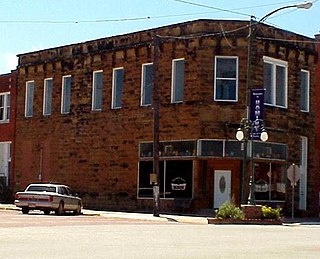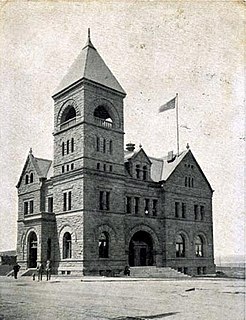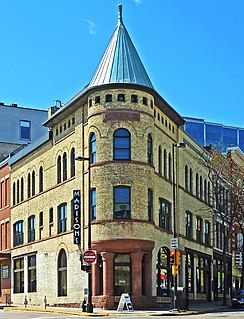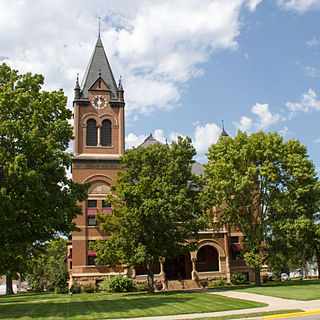
The Bank of Bigheart is a historic commercial building in the town of Barnsdall, Oklahoma. It originally housed the first bank in Barnsdall, which was originally named Bigheart, Oklahoma. The building was added to the National Register of Historic Places on November 23, 1984.

The Bank of Hominy is a building constructed in 1906, two years after the Oklahoma oil boom of 1904. It is one of four small bank buildings built in Richardsonian Romanesque style in Osage County, Oklahoma during 1904-1911. The others are Bank of Burbank, Bank of Bigheart, and Osage Bank of Fairfax.

Allston Congregational Church is a historic Congregational church building at 31-41 Quint Avenue in the Allston neighborhood Boston, Massachusetts. Built in 1890-91 to a design by Allston native Eugene Clark, it is a prominent local example of Richardsonian Romanesque architecture. The property includes a Shingle style parsonage built about the same time. The buildings were listed on the National Register of Historic Places in 1997. The building presently houses a mosque and the Palestinian Cultural Center for Peace.

The First Unitarian Church is a historic church building at 130 Highland Avenue in Somerville, Massachusetts. The stone church was built in the 1894, for a Unitarian Church congregation. It was designed by Hartwell, Richardson and Driver, and is a good example of Richardsonian Romanesque design. The building was listed on the National Register of Historic Places in 1989. As of 1975 the building houses the Mission Church of Our Lord Jesus Christ.

The Old Central Fire Station is a historic fire station at 66 Allen Street in Pittsfield, Massachusetts. Built in 1895, it is the city's oldest surviving fire station, and a prominent local example of Romanesque architecture. The station was listed on the National Register of Historic Places in 1977, and was included in an expansion of Pittsfield's Park Square Historic District in 1991. It now houses offices.

The Walker Building is a historic commercial building at 1228-1244 Main Street in downtown Springfield, Massachusetts. Built in 1898, it is one of the best examples of Richardsonian Romanesque design in the city. It was listed on the National Register of Historic Places in 1983.

The First Christian Church is a historic Disciples of Christ church located at 101 North Tenth Street in Columbia, Missouri. It was designed by T.N. Bell of Chicago, Illinois and built in 1893. It has a Richardsonian Romanesque style Sanctuary that includes a square bell tower, horizontal massing with contrasting high gables, round arches, heavy and highly textured stone work, and voussoir arches. The Education Building was designed by Eugene Groves and added in 1929. This is the second church building to stand at this site. The building is still a functioning church today.

The John N. Bagley House is a private residence located at 2921 East Jefferson Avenue in Detroit, Michigan. It was listed on the National Register of Historic Places in 1985.

The Fisher Hill Reservoir and Gatehouse are a historic element of the public water supply for the Greater Boston area. The reservoir was located on Fisher Road between Hyslop and Channing Roads in Brookline, Massachusetts, and is now the site of Fisher Hill Reservoir Park. It was built in 1886-87 as an early component of the Boston Water Board's expansion of its high service system. The gatehouse may have been designed by Arthur Vinal, who also designed the high pumping station at Chestnut Hill Reservoir. It is a two-story Richardsonian Romanesque structure, with its first floor finished in stone and its second in brick. Brownstone trim is used on the windows and corner quoins, and the voussoirs which form the arches on the first floor. There are pipes to the reservoir and down to Chestnut Hill, and gates for controlling access to local the distribution network. The building was taken out of service in the 1950s.

Trinity Methodist Episcopal Church is a historic former church building at 69 Main Street in New Britain, Connecticut. Built in 1891 to a design by Amos P. Cutting, it is a distinctive local example of Richardsonian Romanesque architecture. Now a performing arts venue known as Trinity-on-Main, it was listed on the National Register of Historic Places in 2007.

The Masonic Temple in Richmond, Virginia is a Richardsonian Romanesque style building built during 1888-1893, designed by Jackson C. Gott. The building was listed on the National Register of Historic Places in 1983.

The Old Ashland Post Office is a historic building in Ashland, Wisconsin, United States. It now serves as the Ashland City Hall, which is what most people know it as, and refer to it as. It houses the offices of city government.

The Thomas County Courthouse, located at 300 N. Court in Colby, is the seat of government of Thomas County, Kansas. The courthouse was built from 1906 to 1907 and replaced the county's original courthouse. Architect James C. Holland designed the courthouse in the Richardsonian Romanesque style. The front of the courthouse has a five-story clock tower with a Seth Thomas clock; the main entrance to the building is located in a Syrian arch at the bottom of the tower. A projecting wing is located on each side of the tower; the wings each have three windows on every story and a hipped roof with a dormer.

The Johnston Library is a historic library located at 210 W. 10th St. in Baxter Springs, Kansas. The building was constructed in 1872 to serve as a courthouse during Baxter Springs' unsuccessful attempt to become the Cherokee County seat. Though Baxter Springs had lost an election to choose the county seat in 1869 to Columbus, supporters of both cities had attempted to fraudulently swing the election in their favor, and Baxter Springs hoped it could still become county seat in the future. The building initially served as the county jail and sheriff's office until Columbus completed its jail in 1880. After this, Baxter Springs ultimately gave up its attempts to become the county seat, and the building became its city hall. In 1905, resident Niles P. Johnston bequeathed $5,000 to the city to start a library, and the city hall building was chosen to house it.

Planters National Bank, also known as the Old Planters Bank, is a historic bank building located in Richmond, Virginia. It was built in 1893, and is a 2 1/2-story, three bay, Richardsonian Romanesque style brownstone building. It has an "I"-plan with three intersecting gable roofs. It features rusticated and elaborately carved facades, a picturesque roof line, and stoned-arched entryway.

The Christian Dick Block is a historic commercial building located at 106 East Doty Street in Madison, Wisconsin. The building was constructed in 1889 for liquor wholesaler Christian Dick. The prominent Madison architectural firm of Conover & Porter designed the Richardsonian Romanesque style building; it is one of the city's earliest extant examples of both the firm's work and the style. The building was added to the National Register of Historic Places in 2002.

The Railroad Street Historic District encompasses a cluster of commercial and railroad-related buildings at the traditional late 19th-century heart of St. Johnsbury, Vermont. It includes five commercial buildings and the town's 1883 union depot, and is reflective of the town's importance as a major railroad junction in northern New England. The district was listed on the National Register of Historic Places in 1974. It was subsumed by the larger St. Johnsbury Historic District in 1980.

The Arkoma School in Arkoma in Le Flore County, Oklahoma was a Works Progress Administration-funded project completed in 1937. It was listed on the National Register of Historic Places in 1988.

The Swift County Courthouse is the seat of government for Swift County, Minnesota, United States, located in the city of Benson. It has been in continual use since its dedication in 1898. The building was designed in Richardsonian Romanesque style by the architectural firm of Buechner & Jacobson. The courthouse was listed on the National Register of Historic Places in 1977 for having local significance in the themes of architecture and politics/government. It was nominated for its longstanding service as the center of Swift County government and for exemplifying the influence of Richardsonian Romanesque style on late-19th-century public buildings.

The Palace Hotel in Gallup, New Mexico, at 236 W. 66th Ave., was built in 1912. It was listed on the National Register of Historic Places in 1988.
























